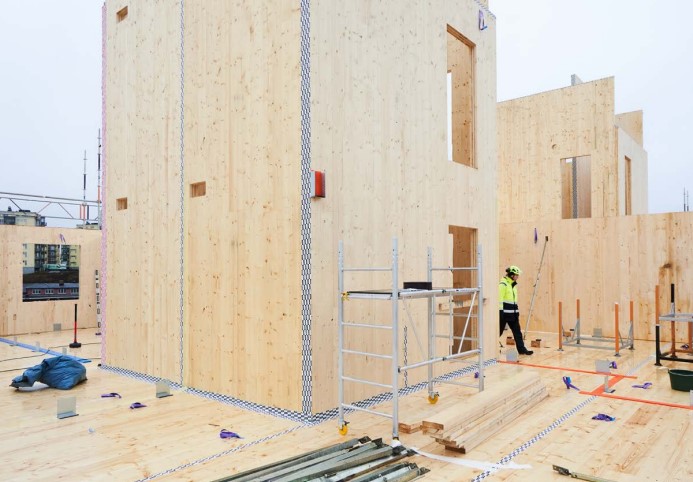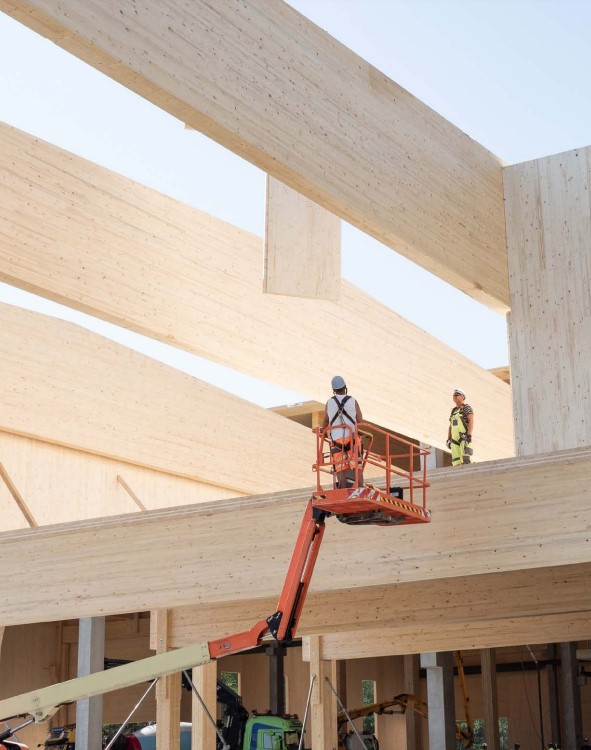Moisture-proof CLT construction without a full temporary shelter
Forward
Because they are delivered with a low moisture content, structural elements in cross laminated timber (CLT) can be enclosed immediately. Elements in other materials may need to dry out before being enclosed. The moisture issue always needs to be addressed, but the method varies for different construction materials.
It is going to rain and maybe even snow during the construction process. The CLT elements are going to be exposed to moisture. But with the right handling, this needn’t be a problem.
The vagaries of the weather can prevent efficient production flows on the construction site, whatever the material being used. It is not uncommon for rain and snow to cause extra work, delays and higher costs. According to a report by the Development Fund of the Swedish Construction Industry (SBUF), efficiency can quickly drop by 20–30 percent due to bad weather. Industrial construction risks being halted at the factory door. One way to keep the industrial process going is to work with some form of full temporary shelter to create a kind of “field factory”. There are plenty of good examples of how such shelters can help to cut construction times and lower costs. The choice of shelter should be decided early on in the project planning. The cost of a full temporary shelter can be set against the cost of the measures that have to be taken when building without a full temporary shelter.
The publication Moisture-proof CLT construction without a full temporary shelter provides guidance on how to handle CLT elements when building without a full shelter. It is intended to help project planners and builders achieve an industrial and dampproof CLT build.
The publication focuses on various parts of the building, critical details and connections. It gives examples of how these can be damp-proofed and how the structural design can contribute to efficient construction in CLT.
The publication highlights the importance of communication, inspections and handling on site. It also provides knowledge about wood and moisture, as well as microbial growth.
The publication has been produced jointly by industry body Swedish Wood and the Swedish CLT manufacturers.
Further technical information and guidance on wood, CLT and timber construction is available on TräGuiden, www.traguiden.se, which is constantly updated with new knowledge and practical advice. TräGuiden is an extensive resource with tables, drawings and illustrations and available in English using Google Translate.
Information on wood, glulam, CLT and timber construction can also be found at www.swedishwood.com.
Stockholm, November 2022
Tomas Alsmarker and Johan Fröbel

Clear communication at every level
The key to a successful construction project is ensuring that the same messages are communicated at every level. It is vital that those planning and implementing the work are involved from the start, and understand how the issue of damp-proofing will be handled – and why. Lack of an overview, confused distribution of responsibilities and unclear communication put damp-proof construction at risk.
The construction sector tends to organise its work in project form, with different tasks divided up into different sub-projects. New people and different teams are brought together to resolve a specific task – their part of the project. Each has a focus on their own task and their business. Most errors occur in the interface between them, which is why communication needs to focus on the gap between the different areas of responsibility. There is much to be gained from ensuring that the people carrying out the different jobs on the construction site are also involved in the planning.
Basic knowledge about wood and moisture should be communicated to everyone who will be planning and doing the work. It is equally important to communicate how the choice of solution, good planning and preventive damp-proofing contribute to dry and efficient CLT construction. Inspection plans and checklists provide useful support, but above all it is about creating understanding and engagement, and being explicit about who is responsible for what.
The communication needs to be involved clear, simple messages, such as:
- Remove free water and snow immediately.
- Sheeting used for damp-proofing must be breathable.
- Water that gets in must be able to get out.
- CLT elements with high moisture content must dry out.
- The surface moisture content should be no more than 18 % prior to being enclosed.
- Moisture – a priority point on the agenda.
- Check every day! It also rains and snows at weekends.
- To measure is to know.
- Snow and rain cost time and money if damp-proofing is not handled well

Chapter 2
The key to a successful construction project is ensuring that the same messages are communicated at every level. It is vital that those planning and implementing the work are involved from the start, and understand how the issue of damp-proofing will be handled – and why. Lack of an overview, confused distribution of responsibilities and unclear communication put damp-proof construction at risk. The construction sector tends to organise its work in project form, with different tasks divided up into different sub-projects. New people and different teams are brought together to resolve a specific task – their part of the project. Each has a focus on their own task and their business. Most errors occur in the interface between them, which is why communication needs to focus on the gap between the different areas of responsibility. There is much to be gained from ensuring that the people carrying out the different jobs on the construction site are also involved in the planning. Basic knowledge about wood and moisture should be communicated to everyone who will be planning and doing the work. It is equally important to communicate how the choice of solution, good planning and preventive damp-proofing contribute to dry and efficient CLT construction. Inspection plans and checklists provide useful support, but above all it is about creating understanding and engagement, and being explicit about who is responsible for what
- Remove free water and snow immediately.
- Sheeting used for damp-proofing must be breathable.
- Water that gets in must be able to get out.
- CLT elements with high moisture content must dry out.
- The surface moisture content should be no more than 18 % prior
to being enclosed. - Moisture – a priority point on the agenda.
- Check every day! It also rains and snows at weekends.
- To measure is to know.
- Snow and rain cost time and money if damp-proofing is not handled well
Chapter 3
The practical damp-proofing work is conducted by various parties,
including planners, contractors and suppliers. The division of responsibility for different activities at different stages may vary, not least depending on the nature of the contract, but knowing who is responsible for what is crucial for successful damp-proofing work.
The developer will usually draw up a damp-proofing description containing relevant requirements, instructions, limit values and so on. The developer should employ a damp-proofing specialist to help in this work. In the case of a turnkey contract, the developer may choose to delegate this task to the contractor. However, overall responsibility still lies with the developer. The developer should employ a damp-proofing expert to help set relevant damp-proofing requirements, draw up an inspection plan, conduct checks and follow-ups, review the design of the frame and the details, train those planning and implementing the project, and not least ensure that the message gets out to everyone concerned.

Chapter 4
The key to a successful construction project is ensuring that the same messages are communicated at every level. It is vital that those planning and implementing the work are involved from the start, and understand how the issue of damp-proofing will be handled – and why. Lack of an overview, confused distribution of responsibilities and unclear communication put damp-proof construction at risk. The construction sector tends to organise its work in project form, with different tasks divided up into different sub-projects. New people and different teams are brought together to resolve a specific task – their part of the project. Each has a focus on their own task and their business. Most errors occur in the interface between them, which is why communication needs to focus on the gap between the different areas of responsibility. There is much to be gained from ensuring that the people carrying out the different jobs on the construction site are also involved in the planning. Basic knowledge about wood and moisture should be communicated to everyone who will be planning and doing the work. It is equally important to communicate how the choice of solution, good
planning and preventive damp-proofing contribute to dry and efficient CLT construction. Inspection plans and checklists provide useful support, but above all it is about creating understanding and engagement, and being explicit about who is responsible for what
- Remove free water and snow immediately.
- Sheeting used for damp-proofing must be breathable.
- Water that gets in must be able to get out.
- CLT elements with high moisture content must dry out.
- The surface moisture content should be no more than 18 % prior
to being enclosed. - Moisture – a priority point on the agenda.
- Check every day! It also rains and snows at weekends.
- To measure is to know.
- Snow and rain cost time and money if damp-proofing is not handled well